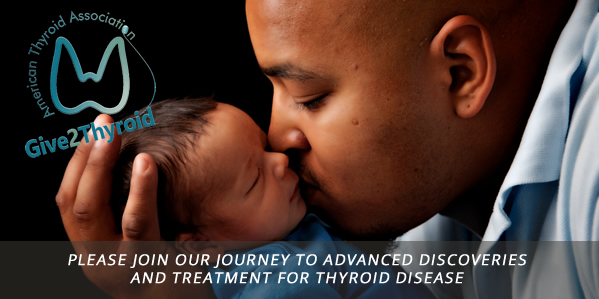Clinical Thyroidology for the Public summarizes selected research studies discussed in the previous month’s issue of Clinical Thyroidology, an official publication of the American Thyroid Association. Editor-in-chief, Alan Farwell, MD, FACE
Volume 11 Issue 11
Available in pdf format for saving and printing and Web page format for viewing online
PDF Format for Saving and Printing
Clinical Thyroidology for the Public Volume 11 Issue 11 (PDF file, 5.99 MB)
TABLE OF CONTENTS – Web Format
THYROID EYE DISEASE A validated tool can predict risk of developing thyroid eye disease during antithyroid drug treatment of Graves’ Disease
Graves’ disease causes eye problems in some people, including eye bulging, loss of color vision, double vision, eye pain and dry eyes. Identifying people diagnosed with Graves’ disease who do develop eye disease is important because early treatment may make these eye problems less severe. The goal of this study is to identify which people diagnosed with Graves’ disease will eventually have eye problems.
Wiersinga WM et al 2018 Predictive score for the development or progression of Graves’ orbitopathy in patients with newly diagnosed Graves’ hyperthyroidism. Eur J Endocrinol 178:635–643. Epub 2018 Apr 12. PMID: 29650691.
(PDF File for saving and printing, 227 KB)
HYPERTHYROIDISM Some patients do not undergo subsequent evaluation following an abnormally suppressed TSH suggestive of hyperthyroidism
The best screening test when a thyroid problem is suspected is measurement of TSH levels. However, when an abnormal TSH is discovered, additional testing is usually required to complete the evaluation. This study was done to see what kind of testing and treatment occurs after a patient is discovered to have a low TSH test.
Asban A et al 2018 Hyperthyroidism is underdiagnosed and undertreated in 3336 patients: an opportunity for improvement and intervention. Ann Surg 268:506–512. PMID: 30004926.
(PDF File for saving and printing, 117 KB)
HYPERTHYROIDISM Treatment-induced hypothyroidism reduces long-term posttreatment cardiovascular morbidity and mortality in Graves’ Disease and Toxic Multinodular Goiter
Thyroid hormones have major effects on the heart and palpitations and irregular heart rhythms are frequent symptoms caused by hyperthyroidism. Because of this, hyperthyroidism is associated with increased cardiac problems. This study examines the effect of radioactive iodine therapy and surgery on long-term heart disease outcomes in patients with Graves’ disease and toxic multinodular goiter and the relationship of these outcomes to post-treatment thyroid status.
Essi R et al 2018 Cardiovascular morbidity and mortality after treatment of hyperthyroidism with either radioactive iodine or thyroidectomy. Thyroid. Epub 2018 Jul 23. PMID: 29882483.
(PDF File for saving and printing, 167 KB)
HYPERTHYROIDISM Quantitative uptake of sestamibi differentiates Type 1 from Type 2 amiodarone-induced thyrotoxicosis
In some patients taking amiodarone, thyrotoxicosis develops, releasing high levels of thyroid hormone into the blood. There are two types of amiodarone-induced thyrotoxicosis that are treated differently, but diagnosing the different types can be difficult. The aim of this study was to analyze the usefulness of sestamibi in differentiating between the types of amiodaroneinduced thyrotoxicosis.
Censi S et al 2018 Amiodarone-induced thyrotoxicosis: differential diagnosis using 99mTc-sestamibi and targetto- background ratio (TBR). Clin Nucl Med 43:655–662. PMID: 30036255.
(PDF File for saving and printing, 287 KB)
HYPOTHYROIDISM A novel, futuristic method of thyroid hormone treatment
Since some hypothyroid patients do not feel well on T4 alone, there has been interest in combination therapy with both T4 and T3. Currently, T3 and T4 treatments are available but do not provide the T4:T3 ratio seen in individuals with an intact thyroid gland. This study reports the potential use of 2D-printed gel films that can deliver very precise amounts of T4 and/or T3 as a novel, futuristic form of personalized thyroid replacement therapy.
Alomari M et al. Printing T3 and T4 oral drug combinations as a novel strategy for hypothyroidism. Int J Pharm 2018 Jul 29;549(1-2):363-369.
(PDF File for saving and printing, 287 KB)
THYROID CANCER Thyroglobulin levels do not predict recurrence after lobectomy for low-risk papillary thyroid cancer
Patients with small cancers confined to the thyroid gland are more frequently being treated with a thyroid lobectomy. Patients are traditionally monitored for cancer recurrence serum thyroglobulin levels, which is accurate after a total thyroidectomy, but there are few large studies looking at how thyroglobulin predicts recurrence after a lobectomy. This study examines the role of thyroglobulin in predicting cancer recurrence after thyroid lobectomy.
Park S et al 2018 Changes in serum thyroglobulin levels after lobectomy in patients with low-risk papillary thyroid cancer. Thyroid. Epub 2018 May 30. PMID: 29845894.
(PDF File for saving and printing, 287 KB)





